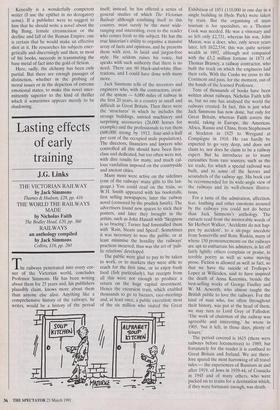Lasting effects of early training
J.G. Links
he railways penetrated into every cor- ner of the Victorian world, concludes Professor Simmons. He has been writing about them for 25 years and, his publishers plausibly claim, knows more about them than anyone else alive. Anything like a comprehensive history of the railways, he writes, would be a history of the period itself; instead, he has offered a series of general studies of which The Victorian Railway although confining itself to this country, must surely be the most wide- ranging and interesting, even to the reader who comes fresh to the subject. He has the true historian's ability to organise a massive array of facts and opinions, and he presents them with zest, in lucid and jargon-free style. He seldom raises his voice, but speaks with such authority that there is no need. There are 60 black-and-white illus- trations, and I could have done with many more.
Jack Simmons tells of the inventors and engineers who, with the contractors, creat- ed the system — 6,000 miles of railway in the first 20 years, in a country as small and difficult as Great Britain. Then there were the 'structures' in which he includes the strange buildings, untried machinery and surprising accessories (26,000 horses for example) and the professionals to run them (600,000 strong by 1913, four-and-a-half per cent of the occupied male population). The directors, financiers and lawyers who controlled all this should have been first- class and dedicated, but too often were not, with dire results for many, and much cal- lous vandalism imposed on the countryside and ancient cities.
Many more were active on the sidelines (one of the railways' many gifts to the lan- guage.) You could read on the train, so W.H. Smith appeared with his bookstalls, first selling newspapers, later the railway novel (censored by the prudish Smith). The advertisers found new spaces to stick their posters, and later they brought in the artists, such as John Hassall with `Skegness is so bracing'; Turner had forestalled them with 'Rain, Steam and Speed'. Sometimes it was necessary to woo the public, or at least minimise the hostility the railways' practices incurred; thus was the art of 'pub- lic relations' developed.
The public were glad to pay to be taken to work, or to markets they were able to reach for the first time, or to enjoy fresh food (fish particularly), but receipts from all this were not enough to produce a return on the huge capital investment. Hence the excursion train, which enabled thousands to go to bazaars, race-meetings and, at least once, a public execution; most of the six million who visited the Great
Exhibition of 1851 (110,000 in one day in a single building in Hyde Park) were taken by train. But the organising of mass tourism is for specialists, so a Thomas Cook was needed. He was a visionary and so left only £2,731, whereas his son, John Mason, was a doer, who, only seven years later, left £622,534; this was quite serious wealth in 1892, although not compared with the £3.2 million fortune in 1871 of Thomas Brassey, a railway contractor, who built the track on which the engineers laid their rails. With the Cooks we cross to the Continent and pass, for the moment, out of the hands of the learned Professor.
Tens of thousands of books have been written about railways, Nicholas Faith tells us, but no one has analysed the world the railways created. In fact, this is just what Jack Simmons has now done, but only for Great Britain, whereas Faith covers the world, taking in Europe, the Americas, Africa, Russia and China, from Stephenson at Stockton in 1825 to Weygand at Compiegne in 1918. He can hardly be expected to go very deep, and does not claim to, nor does he claim to be a railway expert. But he introduces us to many curiosities from rare sources, such as the ice trade, for which a special railroad was built, and to some of the heroes and scoundrels of the railway age. His book can be recommended for its wide-angle view of the railways and its well-chosen illustra- tions.
For a taste of the admiration, affection, fear, loathing and other emotions aroused by the railways you could not do better than Jack Simmons's anthology. The extracts read from the memorable words of Sir Herbert Walker, 'Accidents do not hap- pen by accident', to a six-page anecdote from Somerville and Ross. Ruskin, many of whose 150 pronouncements on the railways are apt to embarrass his admirers, is let off fairly lightly; others complain or praise, in terrible poetry as well as some moving prose. Fiction is allowed as well as fact, so that we have the suicide of Trollope's Lopez at Willesden, said to have inspired the death of Anna Karenina, beside the best-selling works of George Findley and W. M. Acworth, who almost taught the British public to love the railways. For the kind of man who, too often throughout their history, was put at the head of them, we may turn to Lord Grey of Falloden: 'The work of chairman of the railway was agreeable and interesting,' he wrote in 1905, 'but it left, in those days, plenty of leisure.'
The period covered is 1615 (there were railways before locomotives) to 1989, but fortunately for the reader it is confined to Great Britain and Ireland. We are there- fore spared the most harrowing of all travel tales — the experiences of Russians in and after 1919, of Jews in 1939-44, of Cossacks in 1945 and of many others, who were packed on to trains for a destination which, if they were fortunate enough, was death.


























































 Previous page
Previous page